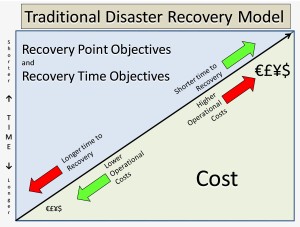 Disaster recovery and business continuity. Recovery point objectives and recovery time objectives. Backing up data to offsite locations, and potentially running mirrored processing sites – it is an expensive business requirement to fulfill. Particularly for budget conscious small and medium-sized companies.
Disaster recovery and business continuity. Recovery point objectives and recovery time objectives. Backing up data to offsite locations, and potentially running mirrored processing sites – it is an expensive business requirement to fulfill. Particularly for budget conscious small and medium-sized companies.
Christoph Streit, founder of Hamburg-based ScaleUp Technologies, believes cloud computing may offer a very cost-effective, powerful solution for companies needing not only to protect their company’s data, but also reduce their recovery point objectives to near zero.
“In a traditional disaster recovery model the organization must have an exact duplicate of their hardware, applications, and data in the disaster recovery location” explains Christoph. “With cloud computing models it is possible to replicate applications virtually, spinning up capacity as needed to meet the processing requirements of the organization in the event a primary processing location becomes unavailable.”
ScaleUp did in fact demonstrate their ability to replicate databases between data centers in an October 2009 test with Cari.net, where ScaleUp was able to bring up a VPN appliance and replicate data and applications between Germany and Cari.net’s data center in San Diego, California.
While there may be issues with personal data being in compliance with European Data Protection Laws, nearly every company and organization around the world participates in a global market place. This means applications and data serving the global market cannot be considered local, and the next logical step is to extend access and presentation of the company’s network presence as close to the network edge (customers) as possible.
Some companies may have physical network capacity in multiple geographies, others may look to companies such as ScaleUp to develop relationships with other cloud service providers to allow “federated” relationships.
Until a true industry standard is determined to define data structures and protocols to use between cloud infrastructure and platform providers, it is probably easiest for relationships to develop between companies using the same cloud platform as a service (PaaS) application. Such is the case with ScaleUp and Cari.net, who used a common platform provided by 3Tera’s AppLogic.
The cloud service provider industry will provide a tremendous service to small and medium businesses which normally cannot afford near zero recovery time and recovery point objectives. Whether it is real-time replication of entire data bases, subsets of data bases, or simply parsing correlated data from edge locations at regular intervals, disaster recovery modeling is changing.
A backup location can be made in some cases by logging into a cloud service provider and opening an account with a credit card – or through a very fast negotiation with the service provider. Certainly not without cost, but potentially at a much lower cost of operation than in models requiring physical data center space, hardware, and operations staff at each location.
The important lesson for small companies is that both disaster recovery and a company’s ability to recover from either a physical disaster such as a fire in their data center, or data corruption, may limit or prevent a company’s ability to continue operations. Adding cloud services to the disaster recovery model may provide a very powerful, simplified, and cost-effective model to protect your business.
No comments:
Post a Comment